The Rise of ‘Y-Iso’

Tight ends don’t typically have much say at the line of scrimmage, which is why Chiefs quarterback Alex Smith gets a kick out of Travis Kelce, who has made a habit of barking route changes at him in practice. Much of that is a credit to Kelce’s confidence as he enters what ought to be a breakout season. Much more of it is a credit to a staple of Kansas City’s offensive scheme under Andy Reid: The Y-ISO Trips package.
With the influx of incoming tight ends from collegiate spread offenses, Y-ISO has become increasingly en vogue over the last five years. The formation consists of three wide receivers on one side of the formation and a tight end on the other side, whether he’s a yard away from the offensive tackle with his hand in the dirt or split out to the sideline. The isolation creates numerous coverage mismatches across the field and it can help quarterbacks identify coverage during pre-snap. In Kansas City, it has emboldened Travis Kelce.
“Defenses treat that formation a certain way; they have different rules for it,” Smith told The MMQB. “So sometimes you can declare as soon as you break the huddle. [Travis] thinks just like I do. So he knows right away, right when we break huddle, as he’s getting up at the line he’ll be calling for things. I love when he calls ’em.”
In the late 1970s and 80s, Don Coryell was one of the first NFL coaches to treat the Y position like the centerpiece it would become. He began splitting Kellen Winslow out like a receiver, liberating him from a three-point stance. Since then, coaches across the league have experimented with ways to confound defensive coordinators with tight end alignment. Y-ISO is nothing new—Joe Gibbs is widely credited with innovating the formation in the 80s during his first run in Washington—but its popularity is spiking rapidly.
During the 2011 regular season, the formation was used on 1,569 snaps across the NFL, according to Pro Football Focus. With each team running somewhere north of 1,000 offensive snaps per season, Y-ISO made up 5% of the average offense. Last season, in 2015, Y-ISO was used 11% of the time, league-wide.
Season | Snaps in Y-ISO (league-wide) |
|---|---|
2011 | 1,569 |
2012 | 1,573 |
2013 | 2,342 |
2014 | 3,329 |
2015 | 3,503 |
“It’s hard to pinpoint who exactly innovated it here in the last five years, but most teams that have a tight end with some athletic ability will do it,” says Greg Cosell, executive producer of ESPN’s NFL Matchup produced by NFL Films. “It’s a big part of the NFL now.”
The origin story is elusive, but the appeal is readily apparent from a quarterback’s perspective.
“If a team played man, your tight end is gonna get a safety or a linebacker on him and all the corners are gonna go over there and match up on the receivers,” Smith explains. “The tight end has to be talented enough to win that. That has to be a match up you want, depending on the team you’re playing. There’s probably not many of those match-ups that we don’t look at as favorable with Kelce. He’s that kind of player.”
The teams that do it best are those with the sort of pass-catching tight ends who run precise routes and create size/speed mismatches on a regular basis, so you can probably guess which teams use the formation most frequently. The leading Y-ISO users in 2015, in order of snaps:
Team | Snaps in Y-ISO (2015) |
|---|---|
Chicago | 215 |
Philadelphia | 206 |
Seattle | 188 |
San Diego | 181 |
Kansas City | 164 |
The departure of Bears coordinator Adam Gase for Miami and tight end Martellus Bennett to New England is expected to knock Chicago off this list and elevate both the Dolphins and Pats; Seattle thrived in the set even after losing Jimmy Graham to a season-ending knee injury, and figures to remain atop this list with his healthy return. Carolina, despite not making the Top 5, is viewed as an industry leader with Greg Olsen; Cincinnati was deadly in the red zone when using the formation with Tyler Eifert, and Cleveland found success doing the same with Gary Barnidge; and Kansas City figures to use Y-ISO even more heavily as Kelce hits his professional prime.
As Smith enters his 12th season in the NFL and fourth with the Chiefs, he and Kelce spent time in minicamp expanding their list of go-to route audibles for the ISO, this time without a traditional offensive coordinator (Brad Childress and Matt Nagy will serve as co-coordinators after Doug Pederson’s hiring in Philadelphia). Here’s how it works for the Chiefs and others.
* * *
Week 16: Browns at Chiefs
Having witnessed earlier in the game how the Browns will defend ISO when in man coverage (with a safety one-on-one with Kelce), Smith takes a look at the Browns defense on third-and-10 at the Browns 13 in the second quarter. He sees cornerback Tramon Williams giving Kelce about six yards of space. He’s thinking Cover 4.
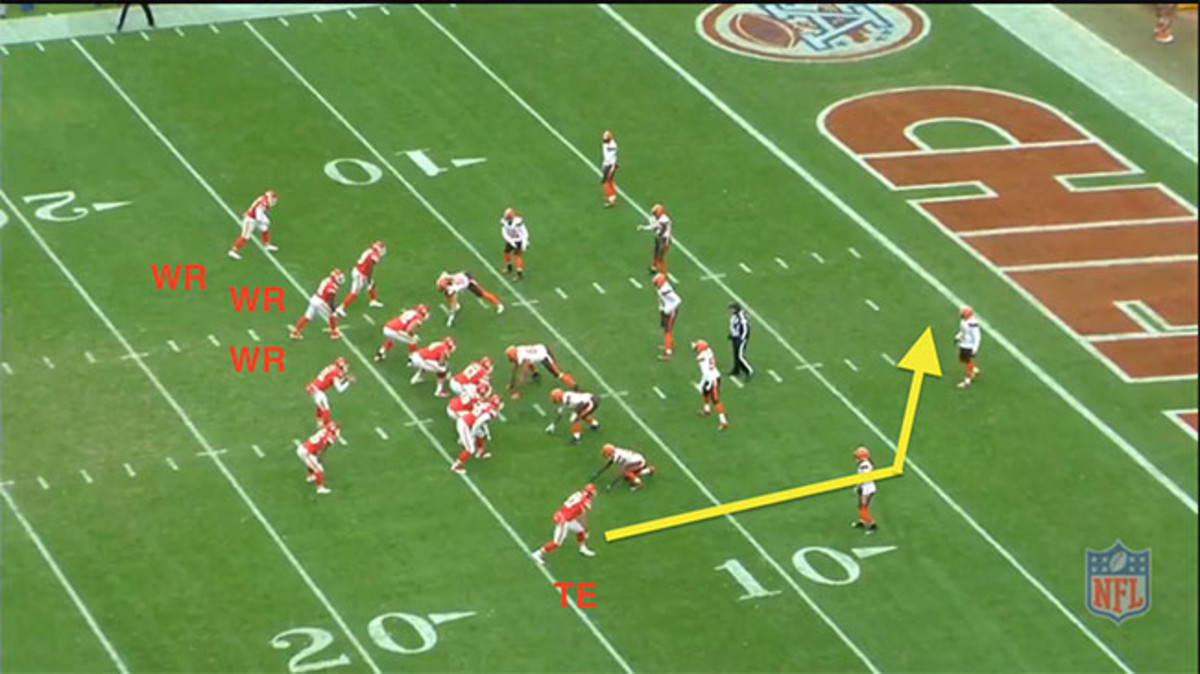
With Kelce running a post, Smith is reading the deep safety; Kelce should be able to wall off the cornerback and make the catch, provided the safety doesn’t jump the route. Using the big-bodied Kelce as the ISO in this scenario serves two purposes: simplifying the read for Smith and expanding the number of viable route options. When the ball is snapped, the safety hesitates, and Smith lets the ball go long before Kelce is open—so long, in fact, that’s it’s not until five steps later that Kelce snags the low and away fastball for a touchdown.
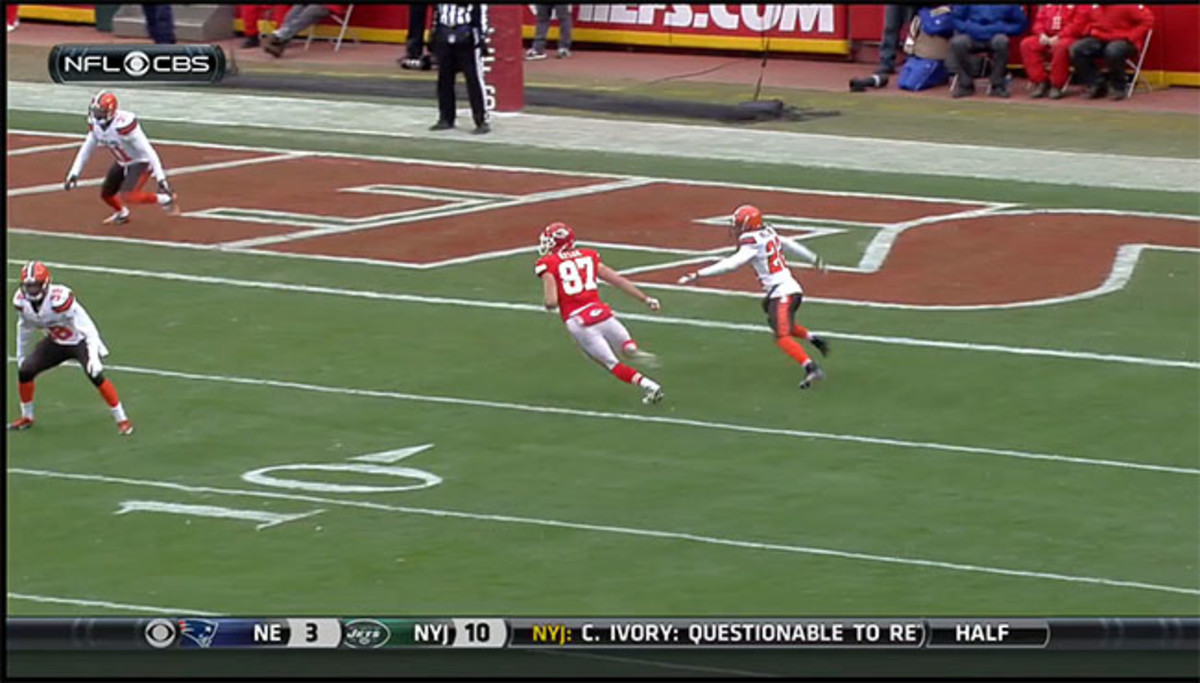
* * *
NFC Divisional Playoffs: Seahawks at Panthers
Few use the Y-ISO better than Carolina and coordinator Mike Shula, who, like Reid, has had success running out of the formation as well. Here’s a pass play example against zone coverage, with Olsen against one of the better teams at defending the iso: Seattle. The Seahawks make little effort here to disguise the fact they are in Cover 3, with Sherman playing well off of Olsen on the right side as he is responsible for a deep third. The Panthers will send a running back out of the backfield to occupy the linebacker in the flat, and will send the inside receiver on the trips side down the middle of the field in an effort to occupy Sherman and free Olsen running a corner route.
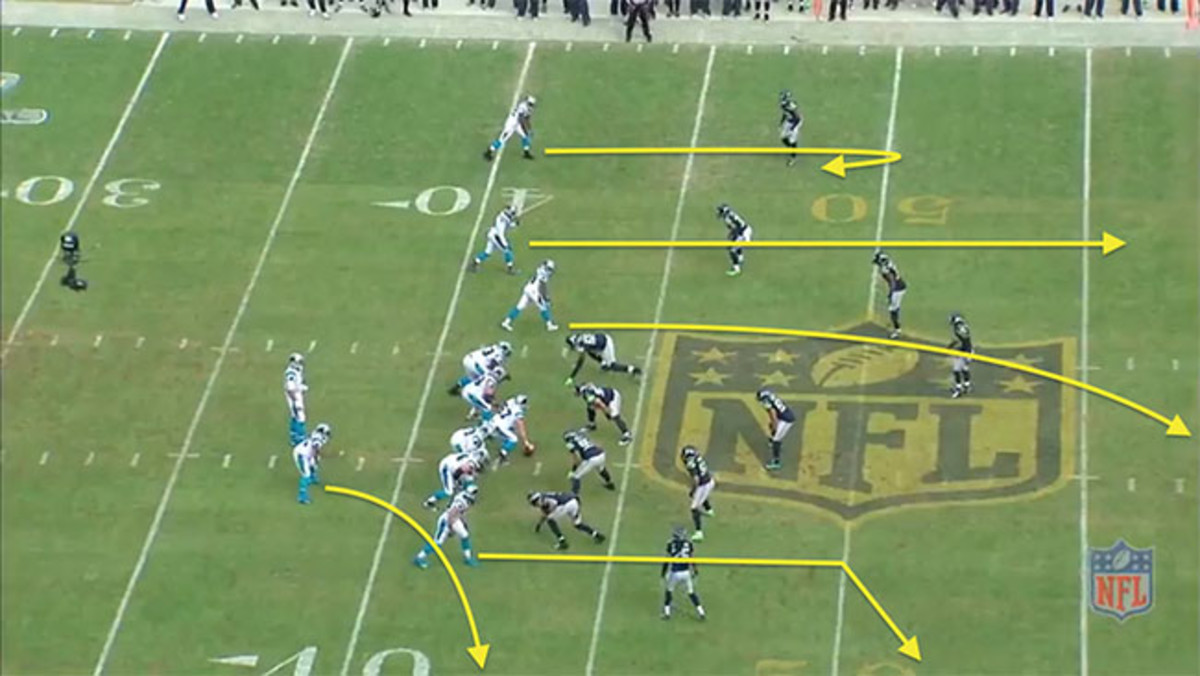
Sherman, perhaps the game’s best cornerback, correctly identifies the streaking slot receiver as the biggest threat and turns his back to Olsen, who reels in a Cam Newton touch pass uncontested for a 27-yard gain.

There isn’t a man within 10 yards of Olsen when he makes the catch for a first down.
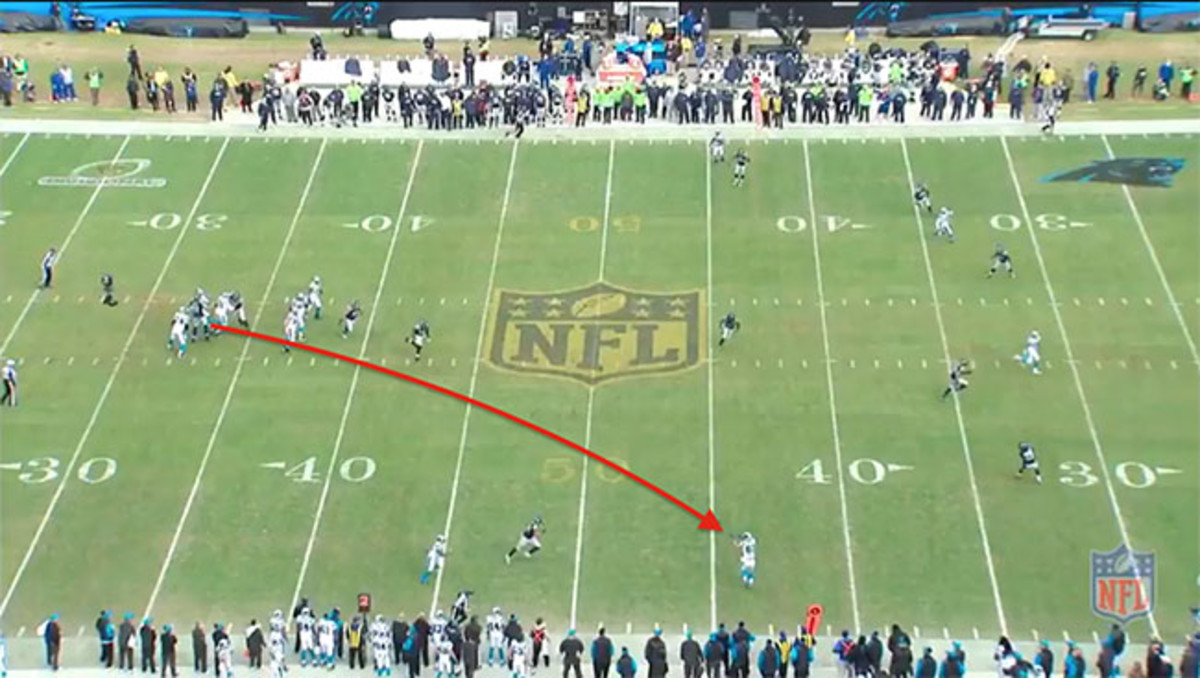
Those were two zone coverage examples. The equation gets simpler when teams respond to the ISO with man.
* * *
Super Bowl 49: Patriots vs. Seahawks
Perhaps the most glaring example of this happened in the second quarter, when Rob Gronkowski split out wide and was followed by linebacker K.J. Wright. Seattle’s three corners were in man coverage on the trips side and safeties Earl Thomas and Kam Chancellor behind them. Wright had more or less survived in man coverage against Gronkowski when the tight end was flanked by receivers, but all alone on the outside, he was burnt toast. Touchdown Pats.

* * *
The teams that truly thrive in the Y-ISO and use it consistently not only pass out of the set but run effectively as well. “Anytime you have a formation that you’re not doing multiple things out of, you know, it’s not going to take very long for defensive coordinators to figure it out,” Smith says. “The reason that we’re able to live in that formation is that we run the ball so well out of it.”
The Chiefs will run both inside and outside zone running plays to the tight end side of the formation as evidenced here.
Week 8: Lions at Chiefs
On second-and-5 in the second quarter, Smith hands off to Charcandrick West while facing a weakside blitz.
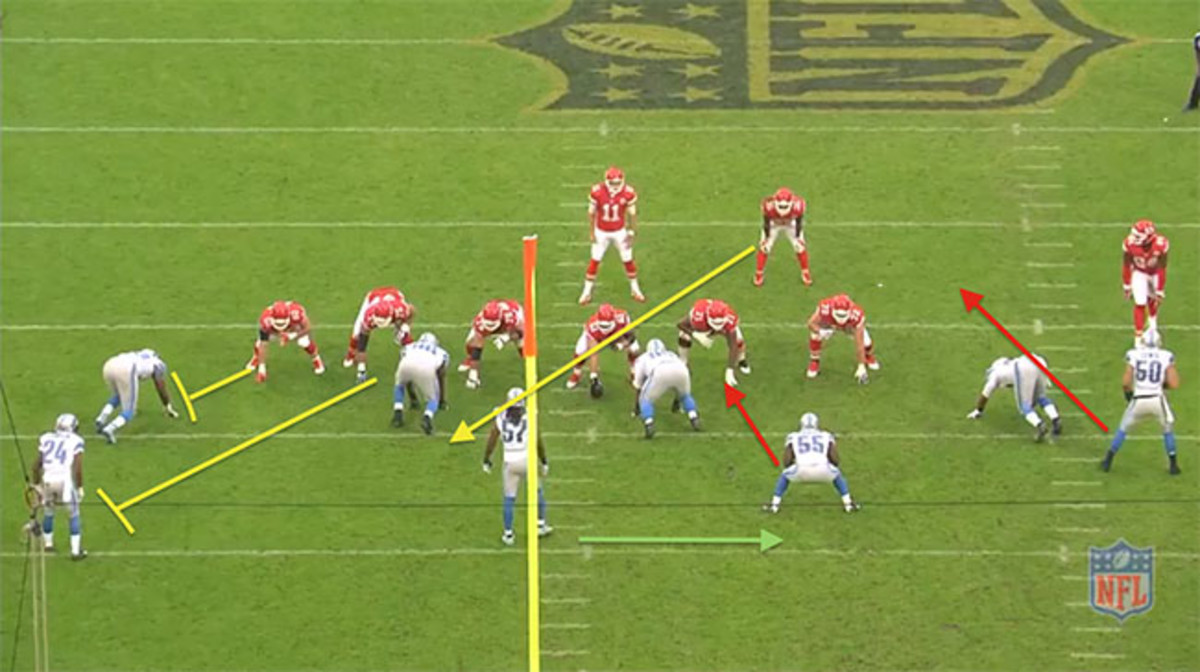
The play-side linebacker is duped by a slot receiver running a dummy screen route.
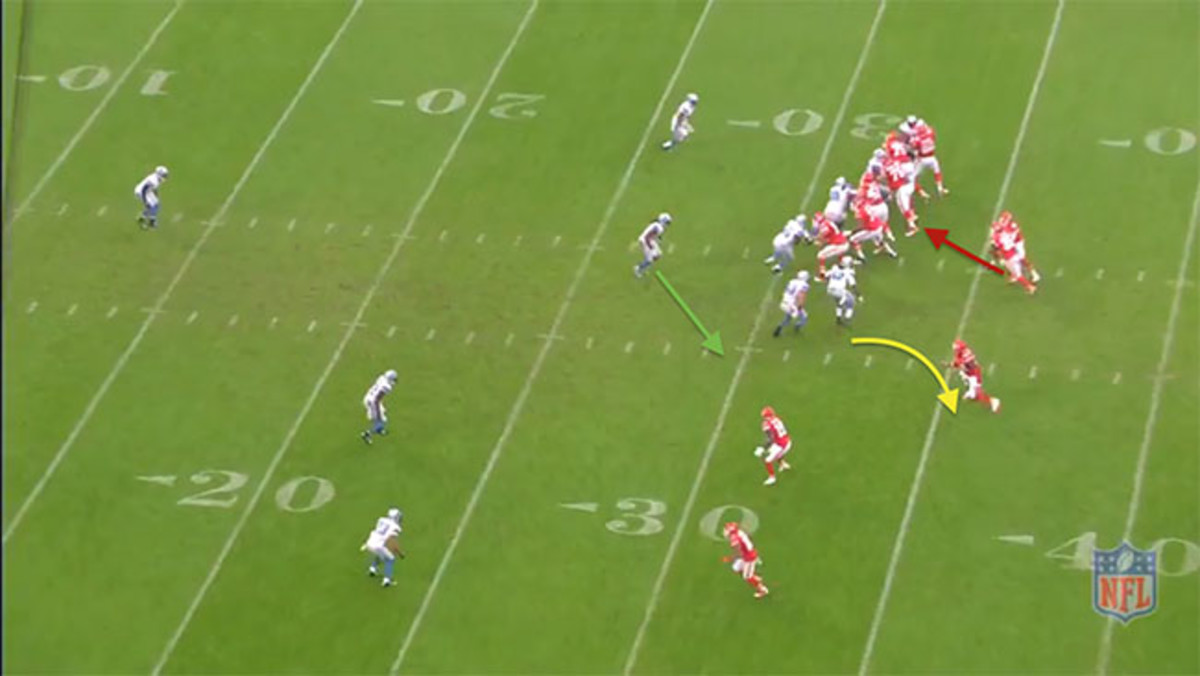
The tight end is able to seal off the edge rusher, freeing the right tackle to take on a defensive back.
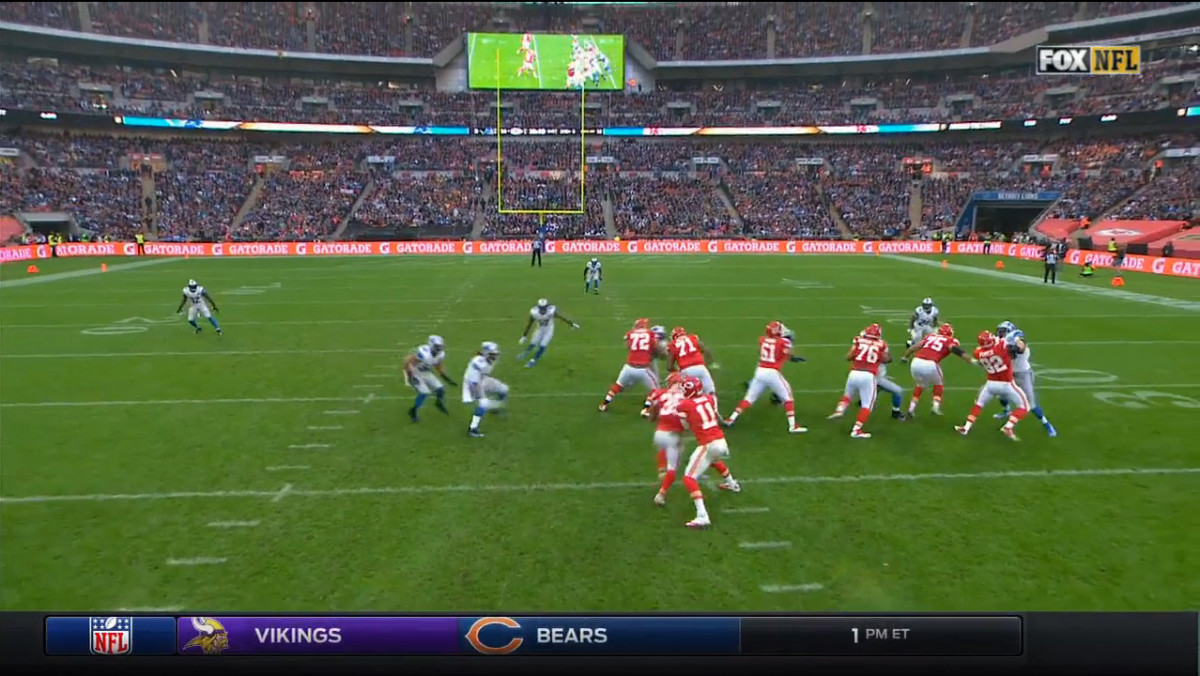
Despite having eight players in the box, the Lions give up 15 yards before the safety finally arrives to make the tackle.
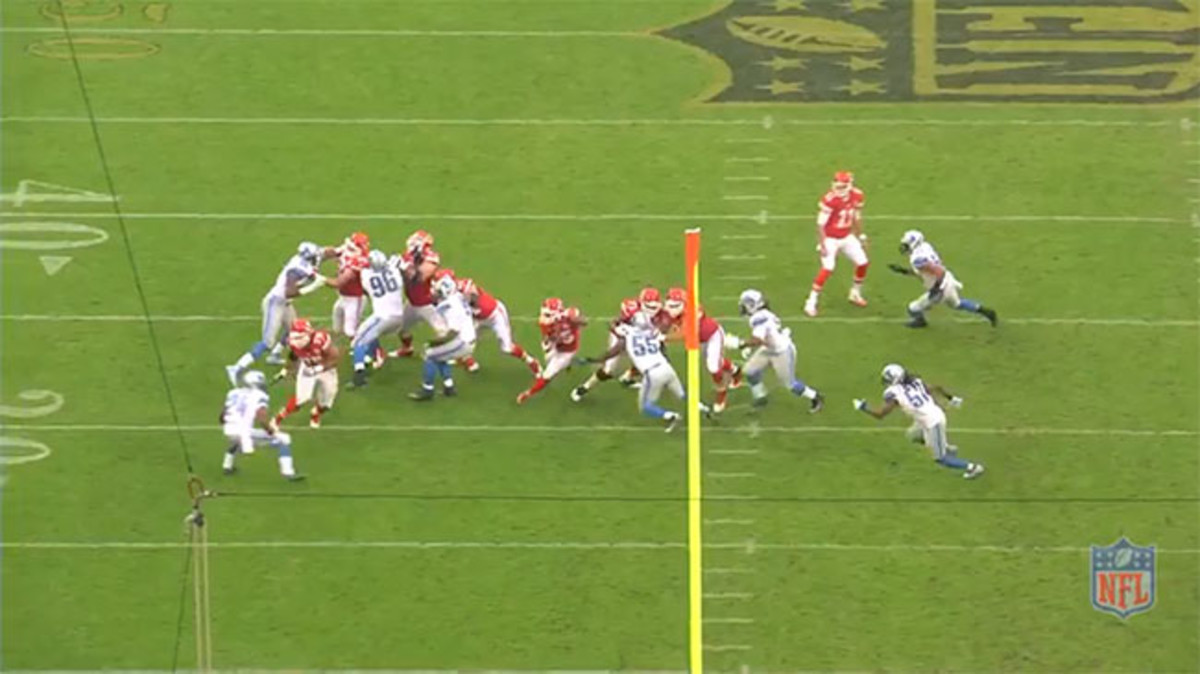
Week 17: Raiders at Chiefs
The Chiefs will also pull a guard to the ISO side and run an inside power play that often yields cutback lanes, but the matchup they really want comes with outside zone runs.
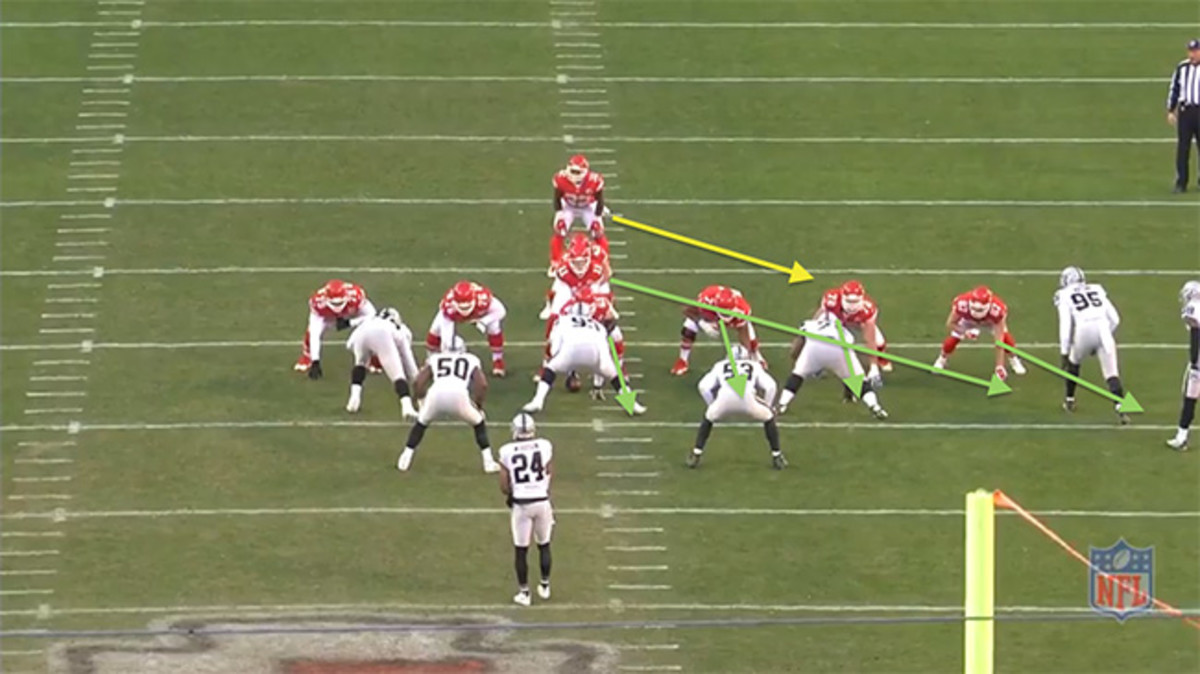
If the tackle or fullback can reach the edge rusher and negate him, you have Travis Kelce kicking out a cornerback and nothing but a safety between the runner and pay dirt. In this case, Charles Woodson was able to make the stop after a 15-yard gain.
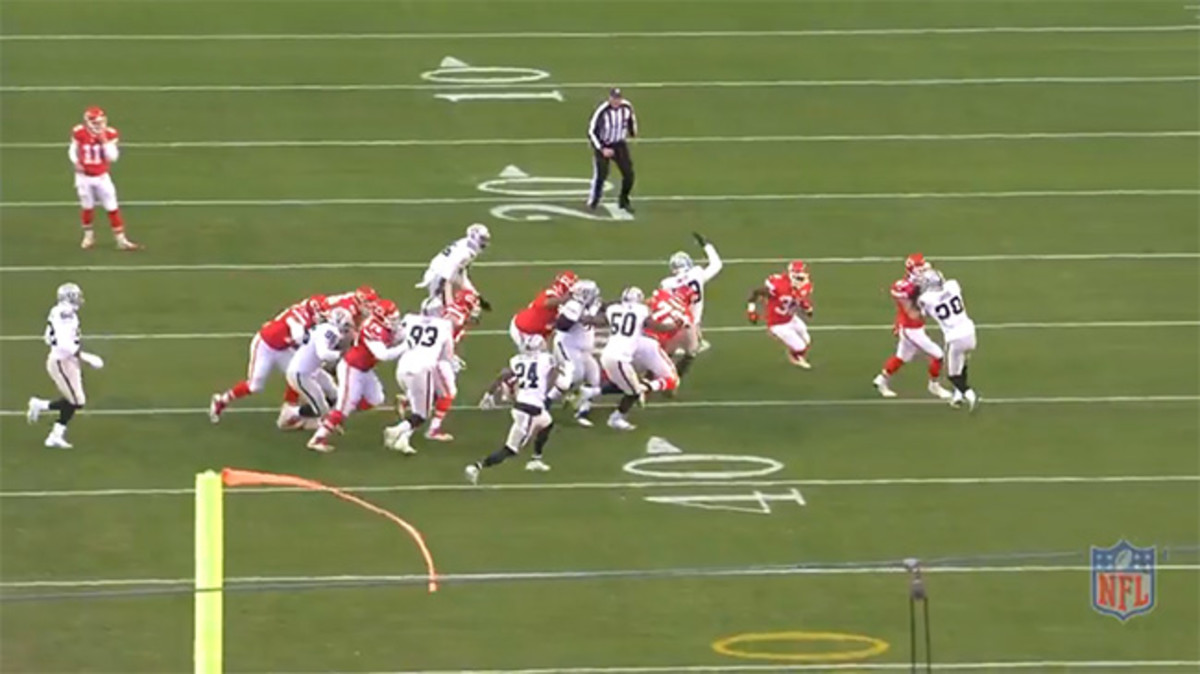
The Y ISO isn’t a cure-all for what ails stagnant offenses, but it can be an outlet for a talented tight end to showcase his all-around skills and a big asset for quarterbacks. If Travis Kelce and the next generation of game-changing tight ends have their way, you’ll be seeing a lot more of it.
Question or comment? Email us at talkback@themmqb.com.
